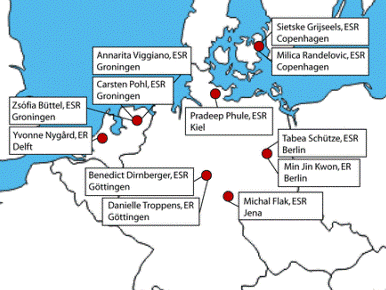
How to cool down a firefighter
 What’s the best way to rapidly cool a firefighter post an emergency response?
What’s the best way to rapidly cool a firefighter post an emergency response?
This question of high occupational relevance is addressed in a review by Matt Brearley and Anthony Walker.
The authors conclude that cooling by immersing a large body surface area in cold water is more effective than only cooling the hands and forearms.
Current consensus is for the latter method, and the authors recommend fire and rescue management around the world reassess this approach. However, at least one firefighter claims to be too much of a wuss to handle multi-segment immersion!
The malaria parasite’s lifecycle
It has been known for a long time that in the malaria parasite Plasmodium falciparum, control of gene expression acts less at the time of transcription of the gene but more during translation.
In this study, the authors investigate an RNA binding protein and show it binds to a subset of mRNAs at specific stages of the life cycle, and that it helps regulate the time at which the mRNAs are translated. This could lead to new targets for intervention strategies of malaria.
Yu et al. Postnatal epigenetic regulation of intestinal stem cells requires DNA methylation and is guided by the microbiome
 The QuantFung project
The QuantFung project
Can we, by unlocking the hidden potential of fungi, discover new antibiotics? In this Commentary, Zsófia Büttel and colleagues introduce the QuantFung project and discuss its goals.
Suckling period vital for lifelong gut health
DNA methylation is a chemical modification of DNA involved in regulating gene expression. There are often changes in methylation when stem cells differentiate into different cell types.
In this study the authors find that mouse intestinal cells do not show many changes in methylation when they differentiated from stem cells to epithelial cells, but there are large changes during suckling, and that these changes are likely to be affected by the gut microbiome. This demonstrates that the suckling period could be vital for epigenetic development of the intestine and potentially lifelong gut health.
 Biomarkers in child mental health
Biomarkers in child mental health
Aribert Rothenberger, an Editorial Board member for Behavioral and Brain Functions, comments on the increasing interest in biomarkers in child psychiatry and how an integration of bio-psycho-social issues may be needed as a mandatory part of research planning.
‘Jamming’ olfaction signals in pest insects
When plants come under attack by herbivores they can release volatile compounds to confuse potential attackers or even attract their attackers’ natural enemies.
Edward Hatano and colleagues unpick some of this chemical warfare, and identify how one such compound can deter herbivores by interfering with their olfaction and orientation systems.
Pathways underlying primordial dwarfism

The authors of this study find two unrelated consanguineous (marriage between two related individuals such as second cousins) families affected by primordial dwarfism.
These families both have mutations in the same gene, and it turns out that this gene encodes a protein responsible for a specific modification of a transfer RNA. Pathogenic variants of tRNAs are quite interesting and this expands on the number of biological pathways responsible for primordial dwarfism.
- Happy Easter! Enjoy the sound (and taste) of your chocolate! - 23rd March 2016
- Quiz: Aiming to make rare diseases common knowledge - 29th February 2016
- Quiz: The big end of year On Biology bumper quiz - 23rd December 2015
One Comment